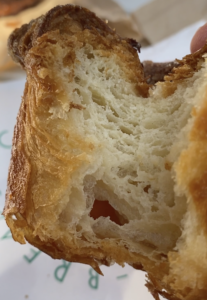Many years ago, Khare asked me (as I think he asked many others at the time) whether I believed their existed an irreducible motive \(M\) over \(\mathbf{Z}\) (so good reduction everywhere) with Hodge-Tate weights \([0,1,2,\ldots,n-1]\) for any \(n > 1\). (Here the Motive is allowed to have coefficients.) When \(n=2\), the answer is no. Assuming all conjectures, such an \(M\) must be modular associated to a cusp form of weight \(2\) and level one, but no such cuspform exists. But the answer is also no unconditionally (for any notion of motive), and this fact is intertwined with the (inductive) proof by Khare and Wintenberger of Serre’s Conjecture. The hope might be that if no such motive existed for all \(n\), it could serve as the inductive basis for a more general form of Serre’s Conjecture.
My response at the time was that I guessed that no such motive existed for any \(n\). I generally feel that my intuition is quite good in these matters, so it was surprising to learn some time later a convincing meta-argument that such motives should really exist. This idea, which I can’t now remember whether I learned from Chenevier or Clozel, is related to trying to construct such forms which are in addition self-dual and so come from a classical group. In favourable situations, there exists a compact inner form on this group, so that computing these forms “reduces” to computing on certain finite sets. One such finite set turns out to be the set of positive definite lattices of discriminant one and dimension \(n\). As is well-known, they only occur in dimensions a multiple of 8. For \(n=8\) there is just \(E_8\), and for \(n=16\) there are two, and for \(n=24\) there turn out to be exactly \(24\), as classified by Niemeier, and which include the famous Leech lattice whose automorphism group is a central extension of the first sporadic group discovered Conway. Easier to compute is the weighted sum of such lattices by automorphisms; for \(n=24\), for example, this weighted sum is
\( \displaystyle{\frac{1027637932586061520960267}{129477933340026851560636148613120000000}}\)
which is very small, and of course is related to the fact that these lattices are quite symmetric. For \(n = 32\), however, the weighed sum is bigger than \(10^7\), and so there are lots of lattices. You might then think that the existence of these lattices (even just \(E_8\) when \(n=8\)) implies the existence of automorphic forms which then should give rise to the desired automorphic forms on \(\mathrm{GL}(n)\). But there are issues. One concerns the technical issue of trasfering forms between groups which is of course a subtle problem. But there is another. A form which is cuspidal on some group need no longer be cuspidal after transferring to \(\mathrm{GL}(n)\). So to see which forms are cuspidal you really need to do a computation. But these objects are of large complexity — already computing Hecke actions on supersingular points for \(X_0(11)\) is a non-trivial exercise; here the objects involve lattices of enormously high dimension. Chenevier and his co-authors, (including Lannes, Renard, and Taïbi) have done a remarkable job understanding what is going on here. The most basic example of the type of theorem they prove is as follows. When \(n = 16\) so there are two lattices; one can try to compute the action of a Hecke operator \(T_p\), and it turns out (see for example Theorem A here) that the answer involves Ramanujan’s function \(\tau(p)\). But this also tells you that the transfer to \(\mathrm{GL}_{16}\) will have some explicit isobaric decomposition corresponding to twists of the modular form \(\Delta\), and in particular the associated \(\pi\) will clearly not be cuspidal.
At the same time, there are some automorphic arguments which show that cusp forms of level one (and cohomologically trivial weight) cannot exist. Here the idea goes back to the (automorphic) proof of lower bounds for discriminants of number fields by Stark and Odlzyko. The idea in that case to use the explicit formula for \(\zeta_{K}(s)\) to construct an expression (and in particular the normalized version \(\Lambda_K(s)\) which satisfies the functional equation and involves \(N^s\) where \(N\) is the level which is directly related to the discriminant of \(K\)) and ultimately arrive at some expression which is provably non-negative unless the root discriminant of \(K\) is larger than some explicit constant (minus some explicit \(o(1)\) depending on the degree). Mestré generalized this argument to automorphic forms corresponding to other Motives, in particular proving that, assuming conjectures of Langlands type, that there did notexist any abelian varieties over \(\mathbf{Z}\) of dimension at least one (which was proved unconditionally by Fontaine) but also that the conductor of such an abelian variety had to be at least \(10^g\). This was then later generalized by Fermigier (a student of Mestré) and then by Stephen Miller (Rutgers!) to prove that there are no automorphic forms \(\pi\) for \(\mathrm{GL}_n/\mathbf{Q}\) of level one which are cohomological for the trivial representation when \(n < 27\). These are exactly the forms associated (conjecturally) to the motives of weight \([0,1,\ldots,n-1]\). Returning to the conference at Orsay: Chenevier gave a talk on understanding automorphic representations \(\pi\) of level one and low motivic weight, and once again raised the automorphic version of Khare’s question. Now I have known about this question for a long time, but somehow being reminded of a problem can sometimes be the spark to help one think about the question again.
Correcting what was a past failing of my own intuition, I was very happy that George Boxer, Toby Gee, and I were able to come up with a very simple argument to answer both questions; there does exist a compatible family of crystalline Galois representations with Hodge-Tate weights \([0,1,2,\ldots,n-1]\) for some \(n\); for example one can take \(n=105\). Moreover, this compatible system is even automorphic and associated to a cuspidal
\(\pi\) of level one and cohomological weight zero for \(\mathrm{GL}_n\). (With work, it is even “motivic” in the sense that the compatible system can be found inside an explicit algebraic variety over \(\mathbf{Q}\), so it is in particular also pure.) Now while the argument is very simple, it must also be said that is uses some extremely hard theorems; for a start, it uses both the full modularity lifting results of BLGGT (Barnet-Lamb, Gee, Geraghty, Taylor), following Clozel-Harris-Taylor and many others, *and* it uses the even more recent full symmetric power functoriality result for classical modular forms by Newton and Thorne. (Since the paper is only nine pages and the proof only half of that, I won’t explain it here.)
One would still like to prove, of course, that there are a huge number of self-dual forms for all sufficiently large \(n\). And one can naturally ask what is the smallest such \(n\), which we now know satisfies \(27 \le n \le 105\). The expectation is certainly that \(n\) is probably close to around \(32\). It would be nice to know!
Of course, there is an endless list of other tricky problems one can pose of this form. For example, does there exist a regular motive (with coefficients) over \(\mathbf{Z}\) with Hodge-Tate weights \([0,1,\ldots,n-1]\) for some \(n\) which is *not* essentially self-dual?







